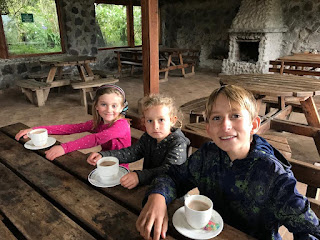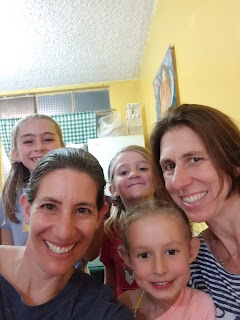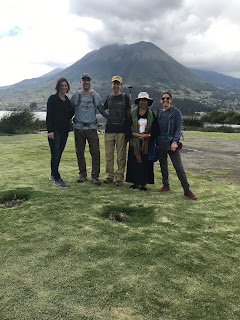Zulay's Otavalo
 |
| Dillon, Jonah, Brynna, Zulay (center), Ella & Joni |
After our visit to Chugchilán, we spent five days in early March with my dear friend, Alana, and her family in Otavalo, a small indigenous city two hours north of Quito. We stayed together at the home of a lovely Otavaleña woman named Zulay, who was a kind and generous hostess. Despite the ways in which Airbnb creates challenges in communities -- most notably by diverting housing that would otherwise by available for local people-- it can offer unique opportunities for connection. This was definitely one of those times.
The Otavaleño people of the northern highlands of Ecuador are considered one of the world's most successful and prosperous contemporary indigenous communities in the world. They have been farmers and weavers since pre-Incan times. Their textile industry flourished even during Spanish colonialism, and, despite modern challenges that have wiped out other indigenous communities, the Otavaleños have been able to maintain a strong cultural identity and gain tremendous economic prosperity.
There are about 40,000 people living in Otavalo; fifty percent identify as indigenous. Walking through town, you regularly see Otavaleño men dressed in dark ponchos, white trousers (though sometimes replaced with jeans), sandals, and one long braid down their backs. The women are universally beautiful -- they wear intricately embroidered lace-trimmed white blouses, layers of beaded necklaces and bracelets, black or navy blue long skirts tied with a faja (woven belt), and alpargatas (thin sandals) on their feet. Most Otaveleños speak Kichwa* as their first language.
Otavalo is well-known for its Saturday market, where thousands of textile workers sell their goods -- everything from hammocks to sweaters to ponchos to hats, and gringos wander the narrow streets trying their hand at bargaining. Though, truth be told, every day in Otavalo is market day. We first wandered through Plaza de los Ponchos on a quiet Wednesday morning, picking out hand-made surprises for Brynna's upcoming birthday and contemplating which woven goods were our favorites. Alana's husband, Tim, got himself a beautiful sweater (which I am pretty sure he did not remove for the rest of our trip).
In addition to textiles, traditional Otavaleños maintain a deep relationship with their land; many continue to raise animals and plant wheat, maize, potatoes, lentils, and quinoa. There is a large weekly animal market on Saturday at dawn that precedes the textile market. We saw beautiful fields of maize and beans everywhere we wandered around the outskirts of town.
***
Our hostess, Zulay, was a fascinating character. She was the central figure of a 1989 documentary, titled Zulay, Facing the 21st Century, an anthropological view of the Otavaleño people produced by UCLA School of Film (Go Bruins!). We watched part of the film during our stay, a slow and meticulous portrayal of rural life in Otavalo in the 1980s. Much of the documentary focused on Zulay herself, a young woman reflecting on her own culture, as she was navigating homesickness and a new immigrant life in Los Angeles, far from her family.
During our stay, Zulay, who now lives in a small unit behind the main house with four rescue dogs, brought us papas, habas, yuca and tostadas (the kids' favorite). She showed us hand-woven traditional fajas (belts), increasingly rare in an era of machine-made weaving. She took us on the bus to a non-touristy indigenous village to observe how elders still weave mats and fans by hand from reeds at the side of Laguna San Pablo. She brought us firewood and sat on a low wooden stool -- akin to a child's chair -- to light a fire in her traditional fireplace, fanning the flames with the very fan we had purchased earlier that day. She even offered to take us to her finca.
And, on the last day, as we were leaving to catch our bus, Zulay came running out with a beautiful hand-stitched blouse she had made for her daughter decades ago, a birthday gift for Brynna.
Zulay made several important offerings, rare these days in standard tourist contexts: she offered us a glimpse into the native food and culture of her people, she shared deep knowledge and pride of her indigenous community, and she genuinely connected with us, not as tourists but as fellow humans. For all of this, I feel deep gratitude.
***
Other highlights of our stay in Otavalo included a gorgeous hike from the Mirador El Lechero, where a mystical tree up on the mountains not only offers 360 degree views of Otavalo and Imbabura, but also healing powers of its milk.
We hiked down to the awesome Parque Condor, a rescue center for birds of prey (many of you know what bird nerds we have become).
We had an adventure choosing Brynna's birthday piñata at Mundo de las Piñatas and eating hilarious "Dragon Ice", the liquid nitrogen ice cream that had us literally snorting steam out our noses.
And we did my favorite activity of all-- we spent good old fashioned quality time together. Two families on a shared adventure: eating almuerzos, wandering city streets, sipping hot chocolate, playing games, sampling new experiences, and making memories together.
___
*there is great debate in the linguistic literature about whether or not to spell this Indigenous language with a ¨K"or a ¨Qu¨, but as of 2004, scholars have agreed that the Kichwa alphabet contains 18 letters: a, ch, i, h, k, l, ll, m, n, ñ, p, r, s, sh, t, u, w, y. Thus, I have chosen to write the name of the indigenous language using the indigenous Kichwa alphabet. If you were to write it in Spanish, you may see it written as Quichua. Also note, that this language is related to, but different than the Peruvian Quechua. (Reference: https://gk.city/2014/07/28/no-es-lo-mismo-quichua-que-kichwa/)





























Glad to hear a positive Airbnb story. In ancient city tourist destinations such as Dubrovnik we hear from locals that they have just moved out of town for much of the year; gentrified out by high rental premiums for Airbnb. They have to commute back in to staff the "local" restaurants . This sounds more like what it might accomplish. (FB)
ReplyDelete